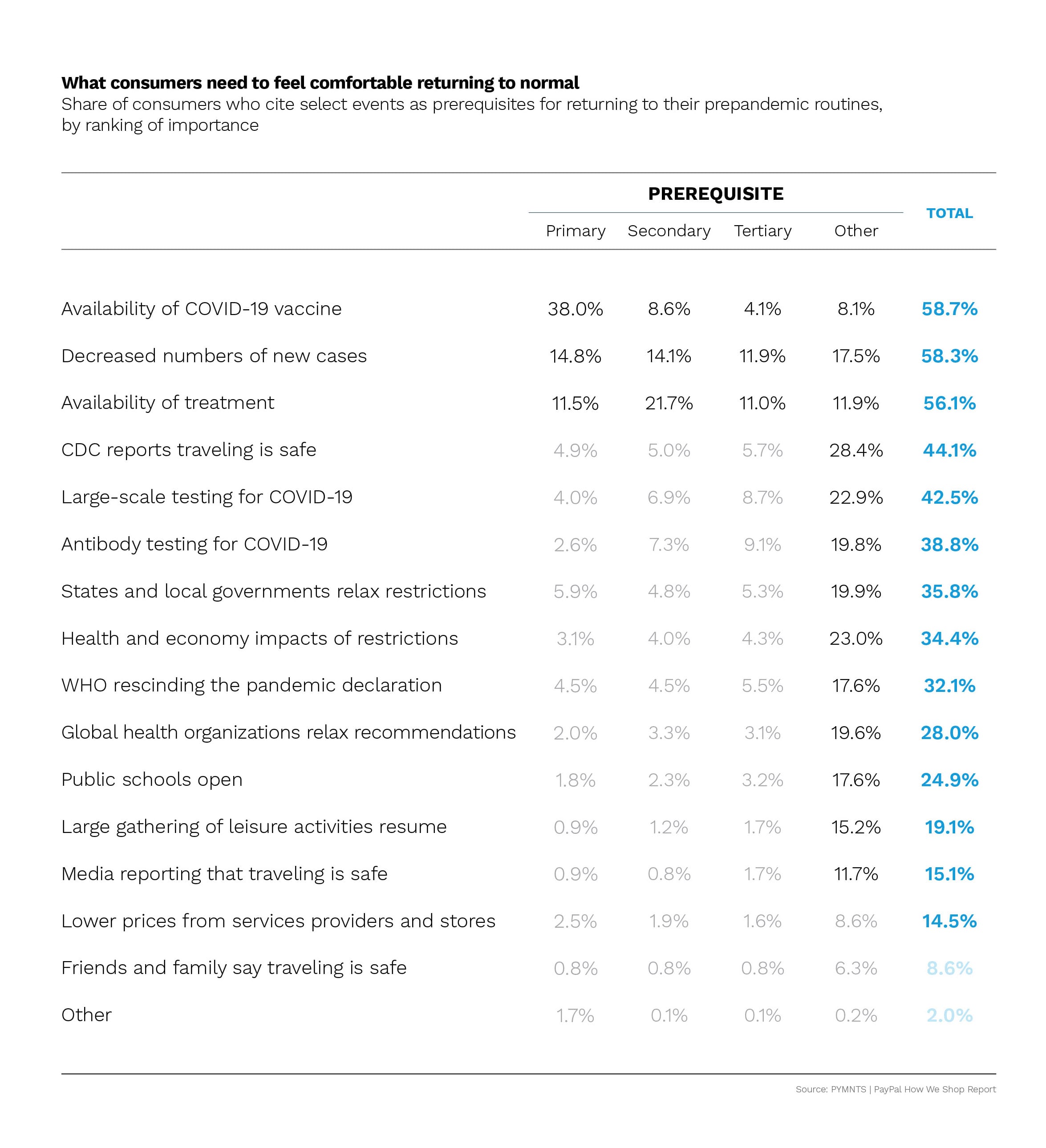What Zoom And Travel Industry Earnings Can Tell Us About The ‘New Normal’

The walk back from the COVID-19 pandemic may have quickened a bit this week, with the announcement that a third vaccine has been officially approved by the FDA this week and will begin rolling out this week. Whether the new vaccine will be a “total game-changer,” as some are saying, remains to be seen — but with yet another route to herd immunity opening up, it can’t help but raise questions as to when normal will return, and what it will look like when it gets here.
Because a vaccine is, notably, what consumers have been waiting on, according to PYMNTS data. When surveyed, some 59 percent reported that they would need to know a COVID-19 vaccine was available before returning to their normal pre-pandemic activities, and 38 percent listed it as the single most important condition to be met.
While questions remain about how proactive consumers will be about getting one of the vaccines, their arrival does mean that the time period wherein COVID-19 dictates everything we do, and how we do, is coming to a close. But even when “normal” is back, will things really look all that different? How many of our old habits have been permanently changed? The answer, as data from various earnings reports over the last few weeks indicates, varies quite widely across segments.
 Zoom Zooms As Connectedness Booms
Zoom Zooms As Connectedness Booms
The team at Zoom, for example, is betting that a mass exodus back to the office won’t be on the agenda anytime soon, and that workers will continue to labor from home. In its latest earrings release, the Silicon Valley teleconferencing firm that exploded in the face of the pandemic projected revenues for the next fiscal year between $3.76 billion and $3.78 billion, solidly ahead of Wall Street projections of around $3.5 billion.
Eric Yuan, founder and chief executive officer, said Zoom has been developing its offering beyond merely being a “killer app” for a certain time and place and more toward being a platform company in a variety of applications.
And that variety was seen to great effect in the year 2020. As Karen Webster noted in her commentary last month, video conferencing has also made it possible for orchestras to play for audiences worldwide, for judges to hear cases, for real estate agents to lead walk-throughs, for customers to meet with personal shoppers, and for teachers to reach students as physical activities have migrated online.
“In the first year of the decade of the 2020s, all of us were collectively left to navigate our way in a world for which there was no playbook,” Webster wrote, noting that such conditions created an opportunity for “innovators to devise more and better ways of doing things in the connected economy, especially as technologies improve. They will be able to tap into the 115 million U.S. consumers — and hundreds of millions more the world over — who have become increasingly acclimated to online life, using platforms and connected devices that save them time, keep their interactions safe and secure, and deliver a far better experience.”
Zoom is an example of just such an innovative player, Webster said, with every right to be enthused and optimistic about its part to play in what comes next. But it’s not the only player emerging from its earnings season feeling confident about its fortunes in a post-pandemic world.
Travel’s Potentially Troubled Recovery Path
Airline earnings were down in Q4, as they were in Q3 and every other quarter of 2020, as the pandemic served to more or less ground the industry worldwide. But airline CEOs have been bullish on the market’s return, particularly in the advent of a vaccine that will allow consumers to travel safely once again. As of last fall, after a punishing round of earnings reports, executives at various airlines were optimistic about the industry’s post-pandemic future.
“Even though the negative impact of COVID-19 will persist in the near term, we are now focused on positioning the airline for a strong recovery that will allow United to bring our furloughed employees back to work and emerge as the global leader in aviation,” said United CEO Scott Kirby.
“We have been encouraged as more customers travel, and we are seeing a path of progressive improvement in our revenues, financial results and daily cash burn,” said Delta Airlines CEO Ed Bastian said in a press statement. “The actions we are taking now to take care of our people, simplify our fleet, improve the customer experience and strengthen our brand will allow Delta to accelerate into a post-COVID recovery.”
But while that pent-up demand is certainly real and evident in PYMNTS data, Webster wonders if perhaps airlines’ hope that the vaccine will act as a business-restoring elixir are a bit misplaced. Business travelers, after all, fill approximately 12 percent of their seats and account for 75 percent of their profits, she noted — and those travelers might find that their communication and connection needs are well-met by video conferencing services like Zoom.
“Their competition is no longer the other guy’s airline — nor the temporary hit to their business caused by a global pandemic. It’s the longer-term, secular shift to digital, led by the democratized access to a software called Zoom that has made their product less valuable,” Webster wrote.
Business executives will, of course, get on the road again, she noted. But with other options available, will they do so with the same frequency as they did in a pre-pandemic world? Probably not.
Because while the future remains unknown, what is visible at this point is that the new economy is a connected economy, powered by technology like Zoom that redefines the boundaries of human connectedness.
